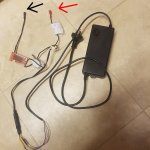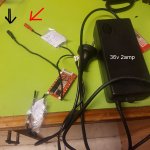whatever
100 kW
- Joined
- Jun 3, 2010
- Messages
- 1,297
This thread probably wont be of interest to those knowledgeable on bms boards, but it might be of interest to someone wanting to convert there standard charger to a balancing type charger. I'll start from the end point and go backwards how this came about.
I'm guessing most premade battery packs will now have a balancing bms board on them, basically all that needs to be done is add a balancing bms to a standard charger ( at this stage I'm not interested in having a balancing bms permanently connected to the battery pack as they normally are).
Pics of the setup:
Charger 36v 2amp with tiny 10s balancing bms board connected, arrows show the bullet connectors that go to the 10s 36v battery pack, so the bms board is permanently connected to the charger

PIc below shows bms board connected to battery pos and neg, and 10s connector also attached to pack.

So that is all is required to balance the pack.
I'm guessing most premade battery packs will now have a balancing bms board on them, basically all that needs to be done is add a balancing bms to a standard charger ( at this stage I'm not interested in having a balancing bms permanently connected to the battery pack as they normally are).
Pics of the setup:
Charger 36v 2amp with tiny 10s balancing bms board connected, arrows show the bullet connectors that go to the 10s 36v battery pack, so the bms board is permanently connected to the charger


PIc below shows bms board connected to battery pos and neg, and 10s connector also attached to pack.

So that is all is required to balance the pack.

